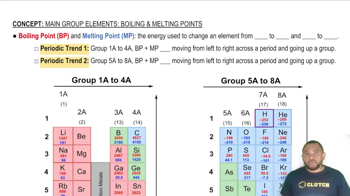Several processes are given in the table and labeled as endo- thermic or exothermic and given a sign for ∆H°. Which process is labeled with the correct sign of ∆H° and correct classification as endothermic or exothermic? (LO 9.8) Process (b) Methane, the main component of natural gas, is burned to produce a flame on a stovetop.
How much heat is required to raise a 50.0 g piece of iron from 25 °C to its melting point of 1538 °C? The specific heat capacity for iron is 0.451 J/g•°C. (a) 34.1 kJ (b) 168 kJ (c) 12.1 kJ (d) 6.78 kJ
 Verified step by step guidance
Verified step by step guidance
Verified Solution
Key Concepts
Specific Heat Capacity

Heat Transfer Calculation

Phase Change and Melting Point

Several processes are given in the table and labeled as endo- thermic or exothermic and given a sign for ∆H°. Which process is labeled with the correct sign of ∆H° and correct classification as endothermic or exothermic? (LO 9.8) Process (c) Water freezes into ice in the freezer.
Several processes are given in the table and labeled as endo- thermic or exothermic and given a sign for ∆H°. Which process is labeled with the correct sign of ∆H° and correct classification as endothermic or exothermic? (LO 9.8) Process (d) Rubbing alcohol evaporates from your skin.
When 12.5 g of NH4NO3 is dissolved in 150.0 g of water of 25.0 °C in a coffee cup calorimeter, the final temperature of the solution of 19.7 °C. Assume that the specific heat of the solution is the same as that of water, 4.18 J/(g•°C). What is the ΔH per mol of NH4NO3? (LO 9.10) NH4NO3 (s) → NH4+ (aq) + NO3−(aq) ΔH = ? (a) +3.60 kJ (b) +23.0 kJ (c) +21.3 kJ (d) −3.60 kJ
